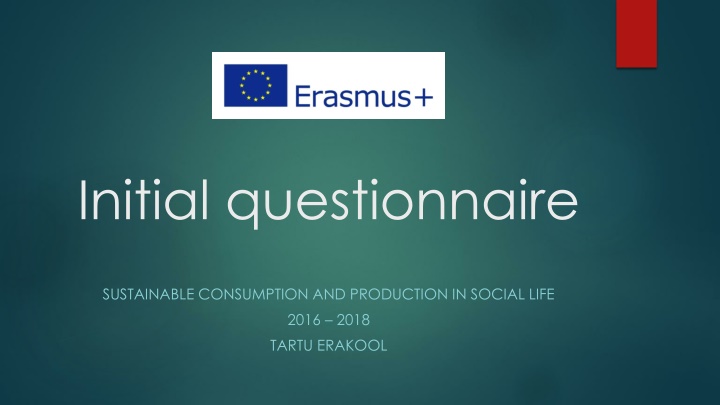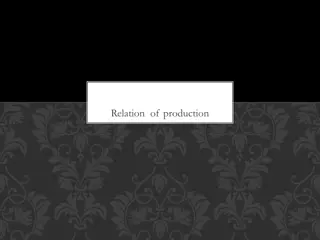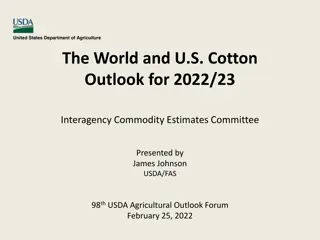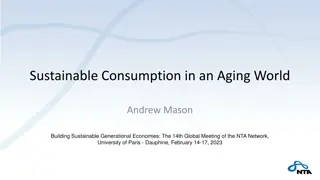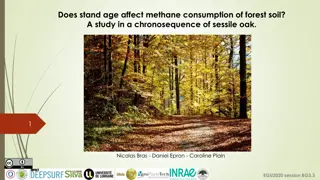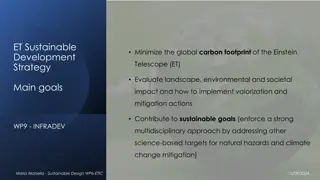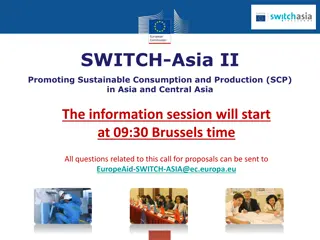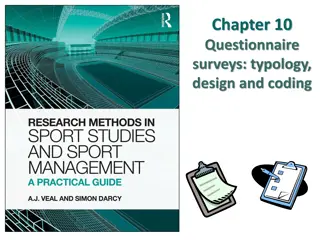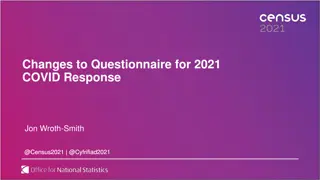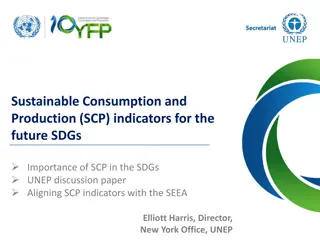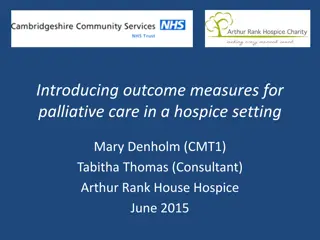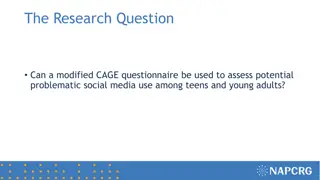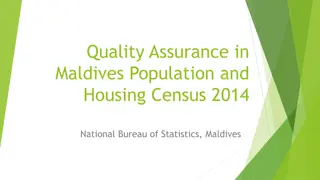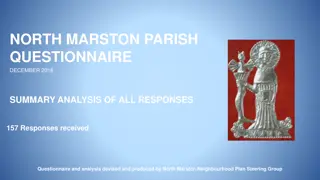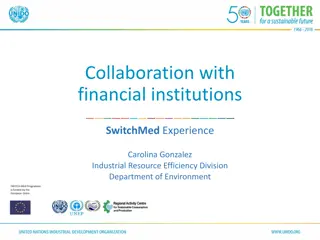Sustainable Consumption and Production in Social Life: Initial Questionnaire Insights
Delve into the world of sustainable consumption and production through an initial questionnaire conducted between 2016-2018 at Tartu Erakool. The questionnaire focuses on key areas such as unsustainable consumption and threats, healthy living, food, and sport, employment and economy, environmental protection, education, and innovation. Gain insights into various sustainability-related topics with multiple-choice questions and correct answers provided.
Download Presentation

Please find below an Image/Link to download the presentation.
The content on the website is provided AS IS for your information and personal use only. It may not be sold, licensed, or shared on other websites without obtaining consent from the author.If you encounter any issues during the download, it is possible that the publisher has removed the file from their server.
You are allowed to download the files provided on this website for personal or commercial use, subject to the condition that they are used lawfully. All files are the property of their respective owners.
The content on the website is provided AS IS for your information and personal use only. It may not be sold, licensed, or shared on other websites without obtaining consent from the author.
E N D
Presentation Transcript
Initial questionnaire SUSTAINABLE CONSUMPTION AND PRODUCTION IN SOCIAL LIFE 2016 2018 TARTU ERAKOOL
In questions 1 to 20 children selected one correct answer. Unsustainable consumption and threats (questions 1-5) Healthy living & Food & Sport (questions 6-10) Employment and Economy (questions 11-15) Environment & Climate change & Environmental protection (q.16-20) In questions 21 to 25 children selected one answer they agreed most. Education & innovation (q.21-25)
Unsustainable consumption and threats 1. World Food Day, established it in 1979 by Food and Agriculture Organization (FAO), is celebrated every year: a) 16 October b) 22 April c) 22 March d) 2 September Correct answers: 41 %
Unsustainable consumption and threats 2. How much food is wasted every year in Europe? a) 1 000 tons b) 10 000 tons c) 50 000 tons d) 100 000 tons Correct answers: 56 %
Unsustainable consumption and threats 3. Smog occurs most often as: a) low residual mixture of fog and pollution in industrialized urban areas during windless weather b) cloud of pollution in rural areas formed during field work and carried by the wind c) thick fog free from impurities, which appears in the morning and making difficult to drive d) a mixture of ozone, oxides of sulfur and nitrogen present in the ozone layer Correct answers: 32 %
Unsustainable consumption and threats 4. One of the ways to save electricity is: a) Buying devices with thermostats, b) Setting the refrigerator close to a heat exchanger for example. radiator, c) Using light bulbs with the lowest brightness, d) setting supreme washing program in your washing machine Correct answers: 100 %
Unsustainable consumption and threats 5. Before throwing the glass jar you need to: a) Wash the jar and then smash it, b) do not remove the labels for easy identification. c) spin the jar, so that water does not get into it, d) remove the metal or plastic nut Correct answers: 59 %
Healthy living & Food & Sport 6. A healthy diet: a) eliminates all use of sugars and salt b) is low in fat c) provides a variety of different foods d) both b and c Correct answers: 47 %
Healthy living & Food & Sport 7. The majority of daily calories should come from: a) breads, cereals, rice and pasta products b) fruits and vegetables c) milk, yogurt and cheese d) meat, poultry, beans or eggs Correct answers: 47 %
Healthy living & Food & Sport 8. Sources of protein include: a) chicken and fish b) beans and peas c) eggs d) all of the above Correct answers: 38 %
Healthy living & Food & Sport 9. A precompetition meal should: a) allow for the stomach to be relatively full at the start of competition b) minimize gastrointestinal distress c) provide protein fuel for the muscles d) provide carbohydrate fuel for muscles Correct answers: 18 %
Healthy living & Food & Sport 10. In general, a solid meal should be eaten _____ prior to competition. a) the day b) 3-4 hours c) 1 hour d) none of the above Correct answers: 56 %
Employment and Economy 11. The workforce in the country is represented by: a) all the people from this country b) all the people in a country who are over 18 years old c) all the people who are capable of working, who have physical and intellectual potential d) all the people who are provided with unemployment benefits/compensation Correct answers: 59 %
Employment and Economy 12. The word `unemployment` refers to the: a) lack of a job abroad b) lack of a job in a country c) lack of a well paid job d) lack of a paid job Correct answers: 38 %
Employment and Economy 13. The gross domestic product (GDP) consists of: a) all the goods and services produced in an economy over a period of time b) all the goods produced in a country c) all the services provided/fulfilled in a given territory d) all the goods consumed by population Correct answers: 35 %
Employment and Economy 14. The products are defined as: a) all the objects or goods obtained in the production process, designed for the customers b) all the activities performed for customers at request, at a certain time c) the entire amount of tourism activities in Romania d) only products that can be found in the grocery stores, which are intended for immediate consumption Correct answers: 50 %
Employment and Economy 15. The salary received by the working people is: a) the amount of money an employee receives in return for the service/work he/she has performed at a work place b) the amount of money that one person receives from another person without having to work c) the amount of money that a student receives from the Government d) the amount of money a person needs to live decently Correct answers: 53 %
Environment & Climate change & Environmental protection 16. What do you call a substance that pollutes the air, water or soil? a)Pollutant b)Pesticides c) Acid d) Sulfur Correct answers: 56 %
Environment & Climate change & Environmental protection 17. Global Warming will cause increase of a) Heat waves b) Hurricanes c) Both d) None of them Correct answers: 50 %
Environment & Climate change & Environmental protection 18. Which of these human activities contributes the most for global warming? a) Using fossil fuels. b) Cutting down trees. c) Riding bicycles. d) None of them Correct answers: 65 %
Environment & Climate change & Environmental protection 19. Which layer protects the Earth from UV rays? a) Oxygen b) Nitrogen c) Ozone d) Hydrogen Correct answers: 59 %
Environment & Climate change & Environmental protection 20. What do you call renewable safe sources of energy a) Alternative energies b) Bio-energies c) Solar energies d) Wind energy Correct answers: 29 %
Education & innovation 21. Can every student be creative? a) some of them 12% b) most of them c) all of them d) none of them 27% 51% 10%
Education & innovation 22. In your opinion what is the most effective for enhancing creative learning? a) allowing students to make mistakes b) using technologies c)experiences such as work and play or risk taking d) discipline 39% 27% 30% 4%
Education & innovation 23. Which certain technologies are the most important for learning? a) educational software b) interactive white boards c) social media 20,6% d) Virtual learning environments 35,3% 29,4% 29,4%
Education & innovation 24. I like a) preparing additional materials from different sources for my favourite classes b) updating my own knowledge c) doing nothing extra d) preparing myself before every lesson 13% 50% 31% 6%
Education & innovation 25. Do you like when a teacher ? a) demonstrates and presents material using technologies b) prepares handouts and additional materials c) uses teaching software that my school has a license d) uses the computer room for classes 25% 20% 25% 30%
Conclusion Our kids ranked highest at unsustainable consumption and threats theme (questions 1-5) with 63,8% correct answers Healthy living & Food & Sport (questions 6-10) got 41,18% correct asnwers Employment and Economy (questions 11-15) got 47,04% correct answers Environment & Climate change & Environmental protection (q.16- 20) 51,76% correct answers
Conclusion Since sustainable consumption are only themes covered by national curriculum at this age stage of children we rate our kids knowledge quite good. We must do more work on healthy living theme and on employment theme. Adding international perspective to these themes will help us cover themes more widely.
